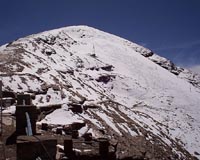| . |  |
. |
Washington (AFP) Nov 13, 2009 Greenland's ice sheet has melted faster than previously thought, according to the results of a two-year study published by the US journal Science. Scientists reported that warmer than usual summers accelerated ice loss to 273 cubic kilometers (65 cubic miles) of a year between 2006 and 2008, amounting to a 0.75 millimeter (0.02 inch) rise in global sea levels per year. "It is clear from these results that mass loss from Greenland has been accelerating since the late 1990s and the underlying causes suggest this trend is likely to continue in the near future," said researcher Jonathan Bamber, one of the authors of the study, released Thursday. The study analyzed satellite data using a new computer model. "We have produced agreement between two totally independent estimates, giving us a lot of confidence in the numbers and our inferences about the processes," Bamber said. Greenland's ice cap contains enough water to cause, if it became fluid, a global sea level rise of seven meters (23 feet). According to the study, since 2000 the ice sheet has lost around 1500 cubic kilometers (360 cubic miles) of water, which amounts to an average global sea level rise of five millimeters (0.19 inches). Researchers said that increased snowfall on the ice sheet has masked a melting increase since 1996, and the refreezing of meltwater also has moderated the effects of ice sheet loss. Without these two moderating effects the study said the overall loss would have been double that observed since 1996. In a landmark report in 2007, the UN's Intergovernmental Panel on Climate Change (IPCC) predicted oceans would rise by 18-59 centimeters (7.2 and 23.6 inches) by 2100. The increase would depend on warming, estimated at between 1.1 and 6.4 degrees Celsius (1.98-11.52 degrees Fahrenheit) this century, which in turn depends on how much man-made greenhouse gases are poured into the atmosphere. Share This Article With Planet Earth
Related Links Beyond the Ice Age
 Warming brings early demise to Bolivian glacier
Warming brings early demise to Bolivian glacierChacaltaya, Bolivia (AFP) Nov 13, 2009 Once home to the highest ski resort in the world and now reduced to a rocky mountainside, Bolivia's Chacaltaya range bears powerful witness to the precipitous melting of glaciers. The rusting remains of a ski lift now dominate what was once the highest ski-run in the world perched on the Chacaltaya glacier at some 5,300 meters (17,390 feet) high. Only a snowy ice cap of some 50 square ... read more |
|
| The content herein, unless otherwise known to be public domain, are Copyright 1995-2009 - SpaceDaily. AFP and UPI Wire Stories are copyright Agence France-Presse and United Press International. ESA Portal Reports are copyright European Space Agency. All NASA sourced material is public domain. Additional copyrights may apply in whole or part to other bona fide parties. Advertising does not imply endorsement,agreement or approval of any opinions, statements or information provided by SpaceDaily on any Web page published or hosted by SpaceDaily. Privacy Statement |